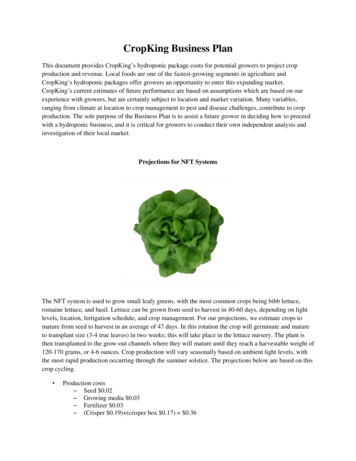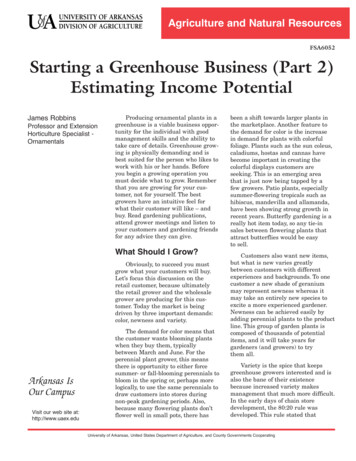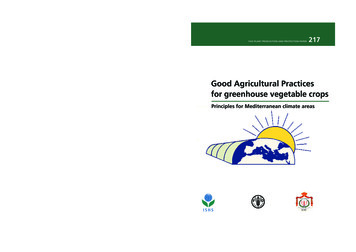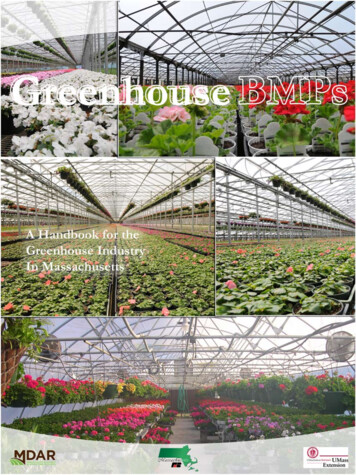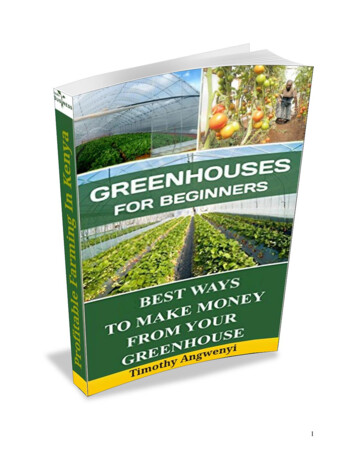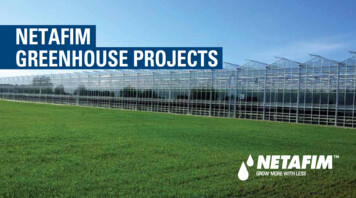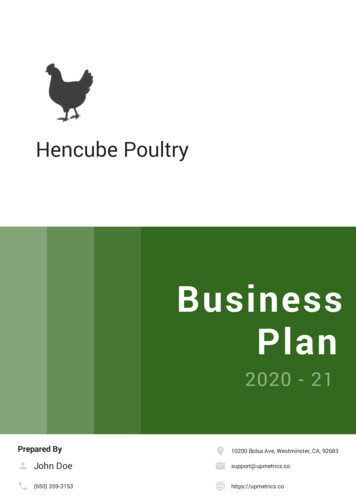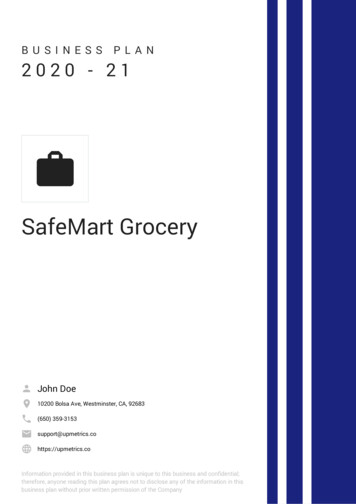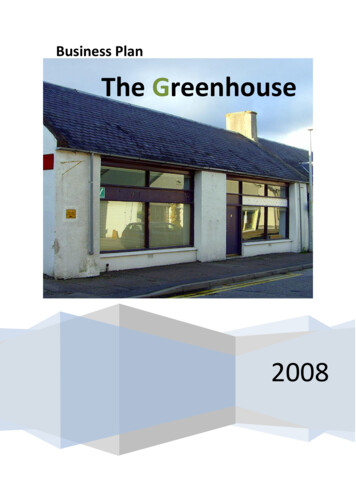
Transcription
Business PlanThe Greenhouse2008
The Greenhouse Business Plan 2008TheGreenhouse will exist for one primary purpose:To receive and sell donated goods for financial profit forsubsequent future reinvestment in the social, community andenvironmental fabric of the area.This document1 will lay out a plan for how this will be realised inthe short, medium and long term. The business plan is roughly infour partsPart One: Shop Operations, Project Viability and MarketingPart Two: Future and Potential OperationsPart Three: Relevant IssuesPart Four: Shop Manager Job Description1This is a draft document and is subject to change.5Hill Street, Dingwall, IV15 9JPPage 2
The Greenhouse Business Plan 2008Part One: Shop Operations, Project Viability and MarketingShop OperationsThe Greenhouse will operate as a not for profit business.The primary method that the business will use for creating profit is by the resale ofdonated goods through two main channels1. High Street Shop2. Online auction sites (Ebay)Credibility and profitability for these two channelsHigh Street ShopThe rapid increase of ‘charity shops’ has been remarkable, from just a handful in the1980’s, to at least one in nearly every town. Dingwall itself has four shops, all dealingwith specific charity organisations. The reason for this dramatic rise has been the evergrowing culture that wants to find a bargain. This has created the market for majorretailers like Tesco and Primark, no longer are we a people driven by quality, it is pricethat matters. This culture may have contributed in some way to the current economiccrisis we are in, but regardless it is a mindset which is here for the foreseeable future.The charity shop was able to meet this need, and this would explain quite well the rapidgrowth of the high street charity shop.Is there room for a fifth shop in Dingwall is a question we have also researched, and theanswer is yes. With the continuing downturn in economic stability people are trying toreduce costs all the time, the charity shop is well placed to assist in this. Peopleinterviewed reported that they would quite happily walk to a fifth charity shop becauseit increased their opportunity to find something that would meet their need. Invernessfor example has 8 charity shops, and most people who use them make a regular circuitaround all of them.This also leads well into location, how important is it to have the shop in the right place?Again research revealed that people were happy to walk a circuit to visit the shops, thestandard of the shop is the only thing that would hinder a customer making repeat visits.So it may well be that being set back from the High St will attract the same customervolume as a High St premises, whilst attracting a lower rent.What makes a good shop? Well we did some survey research and found out that mostimportantly these things made a bad shop: smelly, disorganised, overpriced, tatty goods,unfriendly staff, poorly lit. All the opposite of the above made a good shop as well ashaving all items priced.5Hill Street, Dingwall, IV15 9JPPage 3
The Greenhouse Business Plan 2008Online ShopThis is a market that only a few national charities exploit, but it is one that is significantlyprofitable, three examples of items purchased from charity shops and resold online willmake the point quite clear.1. Timberland boots, purchased from shop for 2 and resold for 26 to UK buyer2. Duran Duran picture cover 12” disc purchased for 50p and resold to Japanese buyerfor 903. Myott vase purchased for 22 and resold to UK based American dealer for 285It is clear that should these have come in the form of donations, then the profit margin isstaggering. Whilst there are packaging, postal and seller fees, a good 75% of these arenormally met by the purchaser. The online shop incurs low costs compared to the HighStreet shop, but it can only truly be practical if working as an outlet for the High St shop.The reason the online shop does so well is the increased traffic, over 750 people viewedthe vase, and many would have been collectors who searched for ‘Myott’. This meanswe would have many potential buyers and not just browsers.Staff Levels and remunerationInitial staffing level will be one person, the manager, who will have recruit volunteerstaff. There may be a requirement to fund a driver/collector, but it is hoped that this canbe done by self employed driver on an invoice per collection basis.Due to initial low staff levels the shop will be open restricted hours, but once volunteerstaff are recruited and trained the opening hours may be extended.The starting salary for the shop manager will be paid in line with other similar positionsfor a basic 36 hour week, but this will be under discussion in the part three. The jobdescription and further details for the position are shown in part four.5Hill Street, Dingwall, IV15 9JPPage 4
The Greenhouse Business Plan 2008Project ViabilityIs there a need for this project?Definitely yes, and it this can be shown from a number of examples.The most salient example could be found in any voluntary group, and that is the subjectof running costs. Most funders provide only start up or specific project costs, but tryfinding someone to pay your insurance or rent is very difficult. It is often only thegeneral goodness of the people running those groups, who so often do not count thefinancial cost to themselves that allows them to continue. Yet this cannot be reliedupon, and many groups fall away because of this. The Greenhouse could go some way tomeeting a lot of these needs.Also funding can be slow in appearing, and also eat up valuable hours spent form filling,and whilst Greenhouse would obviously need some assurance of responsible spending,the local knowledge it had would enable it to respond quickly.There is a need that is less obvious, but is equally important, and that is reward for thosewho donate. In reality we like to know that what we give is used for general good, andwhilst this in some way negates the true essence of selfless giving (left hand not knowingwhat right hand is doing) it is how we are. When we give to Cancer Research, or thePDSA we know we are doing good for very worthy causes, but we are rarely therecipients of that in a direct manner. The Greenhouse will give those who donate thevery real prospect of seeing their gifts grow before their very eyes.People will know where their donations go and see project updates in the shop.To fund social, community and environmental projects we need financial backing, butwe need it with no strings attached and we often need it quickly, the Greenhouse canrespond to this, and that is why there is a need for this project.MarketingIt is recognised that local news will be important to a successful launch, and as DDEG hasbuilt a good relationship with local media, we are hopeful of good coverage. The mainmarketing will be by direct mailing to houses asking for donations, we will systematicallymail the town with A5 flyers.It is also intended to mail businesses to begin a system of business recycling as well asHighland Council Recycling to see what serviceable items can be redeemed from therecycling depot.5Hill Street, Dingwall, IV15 9JPPage 5
The Greenhouse Business Plan 2008Part Two: Potential Future OperationsFREECYCLEDrop off for Freecycle2, one possible gap in the Freecycle network is that not all itemsoffered are collected and not all people use Freecycle. If recycling is to be takenseriously we need a place where goods can be dropped off and taken freely by thosewho need them. The majority of these items currently go to the waste recycling depot,once through the gates they cannot be removed.TOOL BASEPeople have asked for a base where tools can be stored, especially litter pickers etc.Green Gym have also suggested that some volunteers would like to do little bits ofminor works around the town out with Green Gym, including litter picking, if tools wereavailable centrally then volunteers could gain quick and easy access to carry out smalltasks such as litter picking.WALKING BASELocal knowledge of the town is priceless; one example is the River Peffrey. It has cometo light that a great deal happens on this river which is missed by the majority. TheKingfisher and the Stoat (and Otter) recently sighted are good examples. It could be thatthe shop carries an A4/A5 laminated card showing a ‘round the River Peffrey’ walk. Thiscould highlight historical and natural features by using a series of numerical viewpointson the card. Binoculars would be available to hire for the duration of the walk. We couldalso promote the round Dingwall walks network.AUCTION BASEMany people have items they no longer need but do not want to donate to a charityshop. They also do not feel able to take a solitary item to an auction house, neither dothey want the hassle of obtaining an Ebay account, listing, selling and then packing itemfor sale. Greenhouse can act as intermediary, selling items for a percentage of the finalfee. The percentage would have to be higher than an auction house to cover listing,selling and postage fees, this percentage would need to be carefully worked out. Also ifitem did not sell there would still be listing fees. This could also be done through theshop as a static sale.2Freecycle is a worldwide web based organisation that people join for the purpose of freely exchanging goodsthey either no longer need or goods they require. It is possible to advertise items wanted or offered.5Hill Street, Dingwall, IV15 9JPPage 6
The Greenhouse Business Plan 2008ART/PHOTO GALLERYWhilst not wanting to upset our neighbours at Tijo over the road, DDEG do have someartists and photographers among our membership, it would be a great to showcase localtalent by allowing free display space for our membership, and it would brighten up theshop as well as offering potential commissions to the artist/photographer. Our A4photos have proved very successful and just the launch day alone provided over 100 ofsales, of which roughly 70% was profit, we could print these on site.SALE OF GROUP FOODA lot of DDEG members grow their own food, many often having a surplus, this could besold, or better still given away in exchange for volunteer hours/donations etc, a sort ofbarter system. The shop also has growing space at the rear of the shop, it would bewonderful to grow our own food, and it could be the shortest food miles in the UK(World), in fact it would be food ‘inches’. A further benefit of this would be the ability toshow interested customers the food growing process in action, offering advice on howto do it in their own home.SEED EXCHANGE CENTRESome co-operatives have seed exchanges, a day or two in the year when people canexchange seeds rather than always buying new packets. The Greenhouse could have apermanent seed exchange rack for people to freely exchange.FAIR AND ETHNIC TRADES RETAILERNot only Fair Trade, but any trade where money goes directly to source, benefittingpeople far less prosperous than us, some possibilities are already being exploredthrough an outlet in Zambia.CAFÉ/MEETING PLACEThis is more difficult as having a café raises all kinds of food preparation issues, yet themaking of tea and coffee is not a problem. This would also lend itself to later openinghours during the summer possibly. To have somewhere opened till 8pm may be ofbenefit to visitors. The shop could provide board games, magazines etc for customers.PUBLIC INTERNET ACCESSThis would also fit with the café/meeting place idea, and maybe one or two terminalswould be an attractive reason for people to come through the door. With the closure ofMBN we could also provide printing services and other IT services.5Hill Street, Dingwall, IV15 9JPPage 7
The Greenhouse Business Plan 2008INFORMATION POINTI wanted to call this tourist information, but that seemed to be to narrow a view, it is notjust visitors who need information, but residents as well. The shop has four big windows,two of which could be dedicated to providing up to date information. Anything fromlocal B&B’s to Dingwall Players events. Or have a list of ongoing projects, meetings, localbusiness contacts as well as the more common tourist information. We could also havetalks on local and global issues, information on sustainability, recycling etc. There couldbe a local notice board that would display notices such as “I want" or "where can I get"service.FRIENDS OF GREENHOUSEThis could be a list of those who have goodwill towards the shop; current people couldbe DDEG, Dingwall in Bloom, Schools, Farmers Market, Episcopal Church, HighlandCouncil, ROWAN. We could also produce a list of businesses that take recycling andenvironmental issues seriously and contribute to the lessening the impact our town hason the world around us.5Hill Street, Dingwall, IV15 9JPPage 8
The Greenhouse Business Plan 2008Part Three: Relevant IssuesWe have a need to work out how we will discover if the shop is a success, and with usopening in November it is hoped that if we can survive the winter then we should beable to sustain ourselves long term. Along with this we have to consider our costs, sobelow are some of the things we will need to think about in the near future.Start-up, weekly/monthly running costs. Salary for Shop Manager - Percentage or flatrate, is percentage allowed under "not for profit" organisation. Percentage would offeran incentive for manager to be innovative and not just see it as a job.Costs involved in restocking, will people deliver goods, or do we need a van forcollections. If we need a van then could we source a vehicle that would benefit moregroups?What hours to open - 9.00 to 5.00, evenings for talks etc, Staff – Shop Manager, plusvolunteers, stand-in Shop Manager away, possible role for Assistant Shop Manager. Howmany staff at any one time, rotas, training for staff, and where is stock to come from initially and on-going, where to advertise, how often to advertis
The Greenhouse Business Plan 2008 5 H i l l S t r e e t , D i n g w a l l , I V 1 5 9 J P Page 2 TheGreenhouse will exist for one primary purpose: To receive and sell donated goods for financial profit for subsequent future reinvestment in the social, community and environmental fabric of the area.

